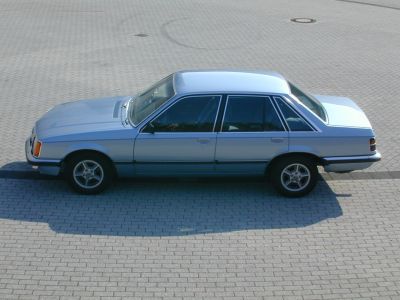 1989 Nissan Maxima III (J30) Dimensions, Size & Specs
1989 Nissan Maxima III (J30) Dimensions, Size & SpecsMeasurements of the 1989 Nissan Maxima III, engineered for optimal performance and comfort
| Dimensions | |
|---|---|
| Length: | 4780 mm188.2 in15.7 ft |
| Width: | 1760 mm69.3 in5.8 ft |
| Height: | 1405 mm55.3 in4.6 ft |
| Trunk Capacity: | 510 liter18.0 cu ft |
| Weight Specifications | |
| Curb Weight: | 1374 kg3029 lbs |
| Maximal permitted Weight: | 1935 kg4266 lbs |
| Tire Specifications | |
| Rims Size: |
|
| Tire Size: |
|
The Nissan Maxima III (J30), produced between 1988 and 1995, represents the third generation of the Maxima lineup, marking a notable evolution in Nissan's midsize sedan segment. Debuted as a 1989 model year, this generation showcased a blend of practicality, comfort, and performance within a well-proportioned vehicle size. Measuring 4780 mm (188.2 inches) in length, 1760 mm (69.3 inches) in width, and 1405 mm (55.3 inches) in height, the Maxima III strikes a balance between spacious interior room and a streamlined, aerodynamic exterior profile typical of late 1980s sedans. Weighing 1374 kg (3,029 lbs) when curb weight is considered, and capable of handling a maximum weight of 1935 kg (4,265 lbs), it assured solid road presence and stability. The luggage capacity of 510 liters (approximately 18 cubic feet) underscores the model's practicality, allowing ample storage for passengers' cargo needs, suitable for family or daily commuting purposes. Equipped with 15-inch rims paired with 205/65 R15 tires, the Maxima III also provides a smooth ride quality and competent handling dynamics for its class. This generation of Nissan Maxima appealed to buyers seeking a comfortable, reliable midsize sedan with efficient use of space and a respectable weight to size ratio. The J30 generation's dimensions place it competitively within its segment, offering enough room for driver and passengers without sacrificing maneuverability in urban environments. Overall, the Nissan Maxima III (J30) 1989 sedan reflects Nissan's commitment to producing vehicles that combine thoughtful design with practical size and excellent driving experience.
Discover the standout features that make the 1989 Nissan Maxima III a leader in its class
Have a question? Please check our knowledgebase first.
The Nissan Maxima III (J30) from 1989 measures 4780 mm (188.2 inches) in length, 1760 mm (69.3 inches) in width, and 1405 mm (55.3 inches) in height. These dimensions reflect the sedan’s moderate size, balancing interior space and maneuverability, suitable for a mid-to-large family car of its time.
The curb weight of the Nissan Maxima III (J30) 1989 is 1374 kg (3,029 lbs), while its maximum permitted weight is 1935 kg (4,265 lbs). This difference accounts for passengers, cargo, and additional equipment. This weight range places the Maxima solidly in the midsize sedan category, offering stability and a comfortable ride.
The luggage capacity of the 1989 Nissan Maxima III (J30) sedan is 510 liters (approximately 18 cubic feet). This sizeable trunk volume allows for ample storage of luggage, groceries, or equipment, making it practical for family trips or daily commuting needs. The large boot capacity is a competitive feature in its class.
The 1989 Nissan Maxima III comes equipped with 15-inch rims fitted with 205/65 R15 tires. This tire size is fairly standard for midsize sedans of that era, providing a good balance between ride comfort and handling performance, ensuring stability and responsive steering characteristics.
The 1989 Nissan Maxima III (J30) with its length of 4780 mm (188.2 inches) and width of 1760 mm (69.3 inches) should fit comfortably in a standard residential garage. Standard garages typically offer dimensions around 6 meters (20 feet) in length and 3 meters (10 feet) in width, providing sufficient clearance for opening doors and maneuvering.
Compared to its predecessor, the Nissan Maxima II, the Maxima III (J30) grew in size, offering more interior space and improved comfort. The J30 increased in length and width, contributing to better cabin roominess and trunk capacity. These dimensional enhancements were part of Nissan's strategy to position the J30 as a more premium midsize sedan.
Against competitors like the Toyota Camry and Honda Accord of the late 1980s, the Nissan Maxima III (J30) was slightly longer and similarly wide. Its 4780 mm (188.2 inches) length offered more rear legroom and trunk space compared to many rivals. This dimensional advantage helped the Maxima stand out as a more spacious and comfortable option in its segment.
The Nissan Maxima III (J30) has an exterior height of 1405 mm (55.3 inches), which is fairly low for a sedan of its size. This lower height contributes to better aerodynamic performance and a sportier driving stance. It also improves stability at higher speeds and gives the car a sleek profile, though it might reduce headroom slightly compared to taller sedans.
The Nissan Maxima III (J30), with its relatively large dimensions for a midsize sedan from 1989, offers generous interior space and comfortable seating, accommodating five passengers. The increase in length and width compared to previous models translates into ample legroom and shoulder room, making it suitable for families and long drives. The 510-liter trunk supports additional cargo needs, enhancing its practicality.
Standard rims on the 1989 Nissan Maxima III (J30) are 15 inches in diameter, paired with 205/65 R15 tires. These tire dimensions provide a smooth ride and a good balance of grip and comfort. The tire profile allows some cushioning against road irregularities while maintaining enough sidewall stiffness for responsive handling, enhancing overall driver confidence.
Discover similar sized cars.

| Production: | 1962-1967 |
|---|---|
| Model Year: | 1962 |
| Length: | 4830-4838 mm190.2-190.5 in |
| Width: | 1790 mm70.5 in |
| Height: | 1470 mm57.9 in |

| Production: | 1964-1968 |
|---|---|
| Model Year: | 1962 |
| Length: | 4874 mm191.9 in |
| Width: | 1803 mm71.0 in |
| Height: | 1470 mm57.9 in |

| Production: | 1967-1975 |
|---|---|
| Model Year: | 1968 |
| Length: | 4874 mm191.9 in |
| Width: | 1803 mm71.0 in |
| Height: | 1470 mm57.9 in |

| Production: | 1968-1975 |
|---|---|
| Model Year: | 1968 |
| Length: | 4839-4870 mm190.5-191.7 in |
| Width: | 1791-1800 mm70.5-70.9 in |
| Height: | 1473 mm58.0 in |

| Production: | 1967-1977 |
|---|---|
| Model Year: | 1968 |
| Length: | 4780 mm188.2 in |
| Width: | 1760 mm69.3 in |
| Height: | 1410 mm55.5 in |

| Production: | 1977-1983 |
|---|---|
| Model Year: | 1977 |
| Length: | 4860 mm191.3 in |
| Width: | 1800 mm70.9 in |
| Height: | 1430 mm56.3 in |

| Production: | 1978-1982 |
|---|---|
| Model Year: | 1978 |
| Length: | 4811 mm189.4 in |
| Width: | 1728 mm68.0 in |
| Height: | 1415 mm55.7 in |

| Production: | 1978-1982 |
|---|---|
| Model Year: | 1978 |
| Length: | 4770 mm187.8 in |
| Width: | 1720 mm67.7 in |
| Height: | 1361 mm53.6 in |
